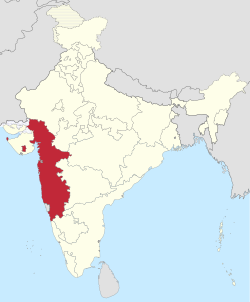Bombay state
|
Province of Bombay (1947 - 1950) State of Bombay (1950 - 1960) |
||||||
| State of India | ||||||
|
||||||
| Bombay State, 1956-1960 | ||||||
| Bombay state in red | ||||||
| History | ||||||
| • | Abolition of the Bombay Presidency, Deccan States Agency and Baroda, Western India and Gujarat States Agency (partial) | 1947 | ||||
| • | Merged Kutch State | 1956 | ||||
| • | Merged Saurashtra State | 1956 | ||||
| • | Divided into Maharashtra and Gujarat states | 1960 | ||||
| Area | ||||||
| • | 1956 | 494,358 km2(190,873 sq mi) | ||||
| Population | ||||||
| • | 1956 | 48,264,622 | ||||
| Density | 97.6 /km2 (252.9 /sq mi) | |||||
|
||||||
| States of India since 1947 | ||||||
Bombay State was a large Indian state created at the time of India's Independence, with other regions being added to it in the succeeding years. Bombay Presidency (roughly equating to the present-day Indian state of Maharashtra, excluding South Maharashtra and Vidarbha) was merged with the princely states of the Baroda, Western India and Gujarat (the present-day Indian state of Gujarat) and Deccan States (which included parts of the present-day Indian states of Maharashtra and Karnataka.
On November 1, 1956, Bombay State was re-organized under the States Reorganisation Act on linguistic lines, absorbing various territories including the Saurashtra and Kutch States, which ceased to exist. On May 1, 1960, Bombay State was dissolved and split on linguistic lines into the two states of Gujarat, with Gujarati speaking population and Maharashtra, with a largely Marathi speaking population..
During the British Raj, portions of the western coast of India under direct British rule were part of the Bombay Presidency. In 1937, the Bombay Presidency became a province of British India.
After India gained independence in 1947, Bombay Presidency became part of India, and Sind province became part of Pakistan. The territory retained by India was restructured into Bombay State. It included princely states such as Kolhapur in Deccan, and Baroda and the Dangs in Gujarat, which had been under the political influence of the former Bombay Presidency.
...
Wikipedia


